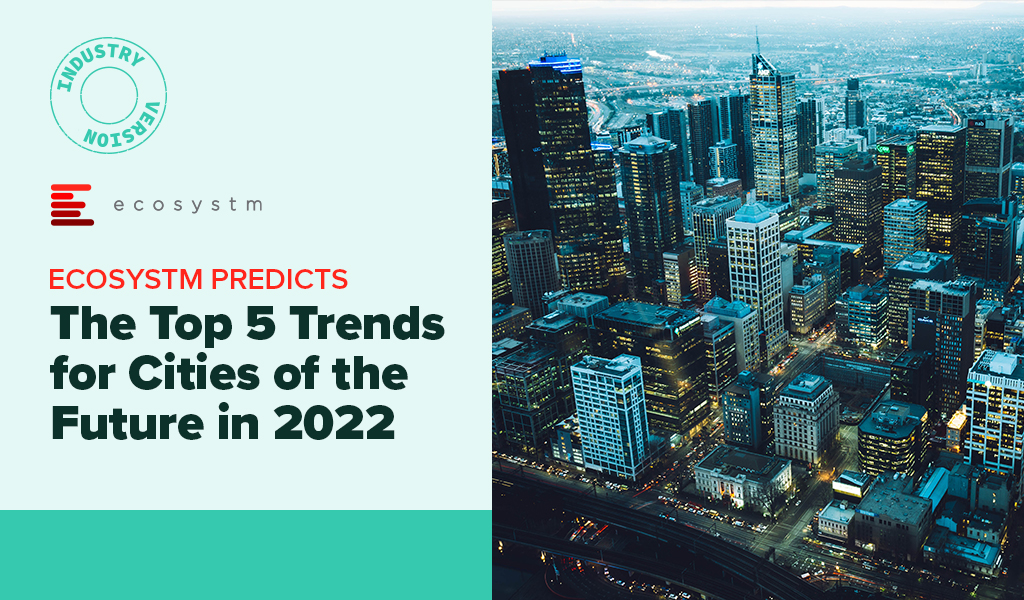Cities worldwide have been facing unexpected challenges since 2020 – and 2022 will see them continue to struggle with the after-effects of COVID-19. However, there is one thing that governments have learnt during this ongoing crisis – technology is not the only aspect of a Cities of the Future initiative. Besides technology, Cities of the Future will start revisiting organisational and institutional structures, prioritise goals, and design and deploy an architecture with data as its foundation.
Cities of the Future will focus on being:
- Safe. Driven by the ongoing healthcare crisis
- Secure. Driven by the multiple cyber attacks on critical infrastructure
- Sustainable. Driven by citizen consciousness and global efforts such as the COP26
- Smart. Driven by the need to be agile to face future uncertainties
Read on to find out what Ecosystm Advisors, Peter Carr, Randeep Sudan, Sash Mukherjee and Tim Sheedy think will be the leading Cities of the Future trends for 2022.
Click here to download Ecosystm Predicts: The Top 5 Trends for Cities of the Future in 2022

Today nearly 56% of the global population lives in an urban environment. The city has finally become the dominant place to live. Given the changing environment and increasing technology, the city has begun to dramatically change in the past 5-10 years. And it will continue to evolve and change at an increasingly faster pace.
As technology has developed and influenced the city, the term “Smart City” has become prevalent. Technology is an important attribute of a city’s evolution. However, it is just one of the attributes. A more encompassing and enduring term could be a “Sustainable City”. The definition of a Sustainable City that I subscribe to is:
“A vibrant community which can adapt and grow over the years, due to changing demographics and economic conditions. It is based upon multiple attributes.”
This definition begins to describe the holistic and long-term issues associated with the complexities of an urban environment. A Sustainable City has a goal of being an enduring and competitive place to work, live, learn, and play. It requires many aspects. Some of these are:
- Purpose. Entertain, eat, work, live, learn
- Activities. Walk, bike, play, work, learn, etc.
- Scale. Human scale not mega blocks
- Natural Environment. Location, terrain, water, etc.
- Environmental Implications. Resource usage, output disposal, environmental footprint, etc.
- Dynamic. Changing through the day/week as needed (festival, farmer’s markets, sporting event)
- Transportation. Walk, bike, mass transit – beyond cars
- Connectivity. Smart & effective infrastructure (utility & transportation coordination, etc.)
- Built Environment. Smart & efficiently operated buildings, spaces, etc.
A city is also a three-dimensional physical puzzle. It is composed of multiple layers: Subterranean level (utilities, transportation, walkways, retail); Ground level (streets, walkways, public spaces, open areas, building entrances); Concourse (walkways, retail, elevated rail, etc.); and Air Space (skyscrapers, bridges). This three-dimensional layout adds a level of complexity.
Key Stakeholders in a Sustainable City
Another important layer to consider consists of the four main players that need to work together:
- People (employees, students, families, tourists)
- Businesses (large, small/medium, start-ups, etc.)
- Built Environment (developers, real estate investors, consultants, designers, engineers, etc.)
- Government (local and regional)
For a city to be enduring and sustainable, the four main players need to work in a concerted effort. They need to discuss, advise, decide and provide for an environment which can change or be modified based upon a particular city’s needs. No one player truly has the ability to control how the city develops over time. Instead all of them work together along with the marketplace and land economics to determine the success of a city in the long run. Idea generation can come from any of these players and is tested in the marketplace. Figure 1 shows the interactions between these four key stakeholders. When all the groups work together, they are able to attain that “Sweet Spot” which enables a location to have the characteristics of a sustainable Global City. In the most simplistic terms, the Sweet Spot for a Sustainable City is the on-going quality of life that the city provides to its occupants.

The Dynamic Nature of a Sustainable City
Some believe that once a city or regional masterplan has been developed and approved the only thing left is to implement and enjoy. As a city and its inhabitants are dynamic, a longer-term sustainable view might be that the completion of the environment is just a starting point. The cases in point are the great global cities whose origins have started many generations ago, such as London, New York, Berlin, Tokyo, and so on This means that through use, the environment and space will constantly be assessed to evaluate if they are meeting the changing needs of the city or location. The appropriate adjustments or modifications are required over time. This is what has been done over the past centuries for many global cities. The difference between then and now is that with technology permeating everywhere, the ability to assess and adjust the environment will now be done at a much faster rate.
As builders and/or occupants of the environment we are just the current Stewards of the urban environment. Stewardship is a delicate balance between Return on Investment and Return to Society. The city is a dynamic environment which will continue to evolve over time based upon its changing needs. We have to determine whether we are going to change and improve the environment or just “pluck the fruits” from the existing assets. We should make sure that when we design and develop the urban environments it is with long-term sustainability in mind.














